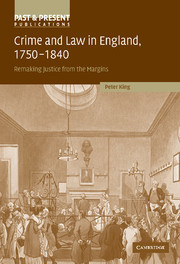Book contents
- Frontmatter
- Contents
- Preface
- List of figures
- List of tables
- 1 Shaping and remaking justice from the margins. The courts, the law and patterns of lawbreaking 1750–1840
- Part I Juveniles
- Part II Gender
- 5 Gender, crime and justice in late eighteenth- and early nineteenth-century England
- 6 Gender and recorded crime. The long-term impact of female offenders on prosecution rates across England and Wales 1750–1850
- Part III Non-lethal violence
- Part IV The attack on customary rights
- Index
- Past and Present Publications
6 - Gender and recorded crime. The long-term impact of female offenders on prosecution rates across England and Wales 1750–1850
Published online by Cambridge University Press: 25 July 2009
- Frontmatter
- Contents
- Preface
- List of figures
- List of tables
- 1 Shaping and remaking justice from the margins. The courts, the law and patterns of lawbreaking 1750–1840
- Part I Juveniles
- Part II Gender
- 5 Gender, crime and justice in late eighteenth- and early nineteenth-century England
- 6 Gender and recorded crime. The long-term impact of female offenders on prosecution rates across England and Wales 1750–1850
- Part III Non-lethal violence
- Part IV The attack on customary rights
- Index
- Past and Present Publications
Summary
Two contradictory views about the impact of female offenders on prosecution rates for major indictable crimes can be found in the current literature. Whilst almost all historians and criminologists agree that women usually represent a smaller proportion of indictable offenders than men and tend to commit less violent offences and to be involved in more petty property offences, there is much less agreement about patterns of change over time. On the one hand many criminological texts stress continuity. Alison Morris recently observed,
Sex differences in crimes have been described as so sustained and so marked as to be, perhaps, the most significant feature of recorded crime. Certainly historical records reveal a disparity between the sexes and more recent statistics in a variety of jurisdictions demonstrate that recorded crime is overwhelmingly a male activity.
Frances Heidensohn's widely used textbook not only concluded that ‘men's excessive contribution to criminality has been observed for almost as long as crime has been recorded’ but also spoke of the ‘stubbornly stable ratio’ of men to women amongst recorded offenders.
Historians working on major indictable crime were, like most criminologists, slow to pick out gender as an important variable. However, starting with John Beattie's pathbreaking work in 1975 this has gradually become a focus of attention and in particular two recent articles by Feeley and Little have posited a completely different model — one of discontinuity rather than continuity.
- Type
- Chapter
- Information
- Crime and Law in England, 1750–1840Remaking Justice from the Margins, pp. 196 - 224Publisher: Cambridge University PressPrint publication year: 2006



